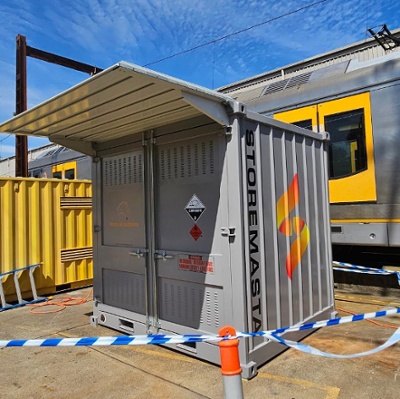Any industry that uses, handles, stores or manufactures dangerous goods requires DG storage. This could be an indoor Class 3 Flammable Liquids cabinet, an Outdoor Chemical Store for corrosives or a Lithium-ion Battery Charging Cabinet. In most cases, there are a multitude of dangerous goods stored onsite, which all require specific storage controls to ensure health and safety as per the requirements of their class or division. In this post, we’ll list some of the many industries that rely on dangerous goods, from traditional industries such as construction or transport to newer sectors such as IT and technology.
REMEMBER: If you require advice for your workplace, get in touch with our Dangerous Goods Storage Consultants. Every workplace has a unique set of risks that need to be controlled, to keep operations safe, compliant and in line with safety guidelines such as the Australian Standards.
What Industries Use Dangerous Goods Storage?
Storage of dangerous goods varies significantly depending on the industry and the specific types of hazardous materials involved.
Some industries which use dangerous goods storage include:
- Aged Care
- Chemical
- Construction
- Defence
- Distilleries & Wineries
- Education
- Equipment Maintenance
- Food & Beverage
- Golf Courses & Buggy Repair Shops
- Hospitality & Leisure
- Laboratories
- Manufacturing
- Medical
- Mining
- IT& Technology
- Transport

The IT or technology industry, which now relies heavily on equipment powered by lithium-ion batteries, is a segment that has a growing need for Class 9 storage.
REMEMBER: Regardless of the industry you’re working in, the storage of dangerous goods is part of a risk management process. This process typically involves chemical identification, risk assessment, proper labeling and signage, employee training, and compliance with relevant regulations and safety standards to minimise the risk of accidents and environmental harm. We also recommend a risk assessment to start your dangerous goods storage process.
DG Storage for Your Industry
Regardless of the type or quantity of dangerous goods that your organisation is carrying onsite, there is a suitable chemical storage solution that can meet the needs of your workplace.
Storage is not only about decreasing risks in your daily tasks due to the containment and storage of harmful substances, but it’s about the functionality and user experience, decreasing risk through the design and construction of equipment that controls the hazards specific to your dangerous goods class or division.
Look for products that help the users of dangerous goods decrease risk through design functionality as well as chemical controls.
We’ll now highlight some key industries and the recommended dangerous goods storage and handling products that can increase safety and efficiency with these operations.
REMEMBER: If you’d like more information about dangerous goods storage for your industry type, visit our By Industry product guide on the website.
Chemical Storage for Aged Care
Aged care may not be an industry you immediately associate with dangerous goods and hazardous chemicals, but there is a specific need for certain types of storage and handling products to reduce the risk of chemical exposure in aged care facilities.
Aged care facilities may also require cleaning chemical storage due to the diligent housekeeping practices required of these facilities, as well as gas cages for oxygen gas for residents.
Product recommendations may include:
- Class 8 Corrosive Storage Cabinets – if your cleaning products are corrosive, they can be safely stored in a Class 8 cabinet. These cabinets offer spill protection, automatic self-closing doors, and perforated shelving which may be easily adjusted to suit the chemical cleaning products stored.
- Medical Gas Cages – as part of the Gas Cylinder Storage range, these Medical Gas Cages are purpose built for the storage of oxygen. Gas cage are suitable for C size, CD Size, and ND size medical gas cylinders.
IMPORTANT: To determine the type of chemical in your workplace, see the safety data sheet. If it’s deemed to be a hazardous chemical, you can see Section 2 Hazard Identification. If the substance or article is a dangerous good, it will be classified in Section 14 Transport Information.
Dangerous Goods Products for Distilleries and Wineries
Distilleries and wineries require flammable liquids primarily for the production process. In the case of distilleries, alcohol is a central component of their operations. In wineries, alcohol is produced naturally through the fermentation of sugars present in fruits, primarily grapes. There may also be additional dangerous goods storage and handling equipment required, such as bunding, drum handling equipment, and corrosive chemical cabinets for cleaners and other sanitisers.
Solutions may include:
- Chemical Bunding – whether it’s floor bunding, steel bunds for flammable substances or bunded drum handling equipment such as a trolley or drum dolly, bunding is an essential measure to control the spread of dangerous goods in any type of manufacturing operation.
- Temperature Controlled Storage – for the safe storage of flammable liquids for the production process. The temperature-controlled store should be equipped with a hazardous area rated HVAC system, and constructed to protect the contents in the harsh outdoor environment.
Storemasta manufactures Class 3 Flammable Liquids stores that are hazardous area IECEx rated with a class 1 zone HVAC system.
Dangerous Goods Storage for Construction
The construction industry involves wide range of activities that enables the planning, design, construction, and maintenance of both structures and infrastructure.
Construction involves everything from residential buildings and commercial properties to roads, bridges, dams, and other large-scale infrastructure projects. Due to the need for relocatable storage, outdoor chemical stores that can be easily moved are an ideal solution.
- Dangerous Goods Storage Containers – fully relocatable and stackable to 2 high, the Storemasta DG Storage Containers are available in 10ft and 20ft models. These walk-in containers are manufactured to meet the Australian Standard 1940, but can be ordered for other dangerous goods classes and divisions, depending on your requirements. Optional add-ons include awnings and dispensing functionalities.
- Gas Cylinder Storage – from LPG gas storage to industrial gases, Gas Cages are a lightweight yet durable storage solution for Class 2 gases. Gas cylinders can be easily transported to a construction site to reduce risks associated with Class 2 dangerous gases.
Golf Courses & Buggy Repairs
There is a vast amount of chemical types required for golf courses – from garden care products, to water treatments for golf course waterway and Class 3 storage for paints and other workshop products.
Add to this the need for golf cart servicing and repairs, plus general usage of lithium-ion batteries in devices, technology and equipment – and you have a battery fire risk that requires control.
Some recommendations for DG storage may include:
- Battery Charging Cabinet – Battery Charging & Storage Cabinets offers flexibility with 18 outlet or 8 outlet options. These cabinets allow lithium-ion batteries to be stored in an environment with fire protection, spill containment and a dual skinned sheet steel non-combustible construction.
- Outdoor Miniseries – dangerous goods storage for the outdoor environment is particularly suitable for the storage of chemicals required for general maintenance. For different DG classes, choose dedicated Miniseries stores located outdoors with regard to segregation requirements, and applicable distances from protection and public places.
The Buggy Man shares his experience with a lithium-ion battery fire at his repair shop for golf buggies in NSW, and what he's now doing to mitigate risk.
Chemical Storage for Manufacturing
Manufacturing often requires the use of mixed classes of dangerous goods, so a mixture of indoor storage and outdoor storage may be required. The manufacturing process may also rely on Class 2 compressed gases, which require compliant storage to reduce the likelihood of chemical exposure through accidental release, flammable gas ignition, and cylinders becoming dangerous projectiles.
- Gas Cylinder Storage – cages which are purpose-built to store your Class 2 gases offer impact protection, restraints to stop cylinders falling over and becoming damaged, plus ample natural ventilation to minimise gas build-ups. These cages should ideally be installed outside, in a protection position out of direct sunlight and away from all incompatible gases and dangerous goods.
- Flammable Liquids Storage Cabinets – flammable liquids are some of the most common dangerous goods. They include adhesives, paint thinners and methylated spirits. You can store smaller quantities of flammable liquids inside, within a compliant Class 3 Flammable Liquids Cabinet. Storemasta offers a vast range from 15L flammable cabinets to 850L large capacity cabinets.
IT & Technology Industry Dangerous Goods Storage
The IT and technology industry has seen a rapid rate of increase when it comes to the need for dangerous goods storage. In particular, it’s the risk of lithium-ion battery fires.
- Outdoor Battery Store – for larger quantities of batteries, the Outdoor Battery Store is a good option. This dangerous goods storage container is equipped with a range of controls to keep batteries in an optimum environment, including hazardous area rated HVAC system, intrinsically safe electrical work, and visual and audio alarm to alert of any fire hazards.
- 18 Outlet Battery Charging Cabinets – there is a growing awareness about the risks associated with charging lithium-ion batteries. While inspections of batteries and careful handling practices are essential, so too is the charging of equipment such as devices, phones and mobility equipment. The 18 outlet cabinet is the largest in the series, offering 3 shelves with 6 outlets providing a 10amp flow in an electrically certified environment that ensures cool, dry and protected storage.
-2.jpg?width=650&height=433&name=500570%20Outdoor%20Battery%20Unit%20Small%20%20(22%20of%2030)-2.jpg)
Transport Industry Chemical Storage
The transport industry is an industry that has typically relied on a wide range of dangerous goods storage products to keep operations running safely. With a mixture of fuels, oils, paints and cleaning products, plus repair activities including welding, there are a range of hazards that must be controlled.
- Aerosol Cages – there are so many different types of aerosols used in vehicle maintenance including degreasers, engine cleaners and spray paints. Aerosol Cages offer the necessary protection to reduce likelihood of cans being damaged and becoming a projectile hazard. They also assist workshops maintain a safe space by providing dedicated storage that must be segregated from incompatible dangerous goods. Aerosols are generally Class 2.1 Flammable Gases, and the aerosol cages come clearly marked with DG diamond and NO SMOKING, NO IGNITION SOURCE signage.
- Floor Bunding – secondary spill containment is an important consideration when setting up any workplace. However, floor bunding offers added protection in vehicle workshops to prohibit fuel or oil spills where buses, trucks or other vehicles are being serviced and repaired.
Choosing Dangerous Goods Storage for your Workplace.
The process of selecting dangerous goods storage doesn’t have to be a complicated one. If you require further information about dangerous goods and the options for safe and compliant storage and handling solutions, why not access our eBook. The Ultimate DG Storage Handbook takes you through all the dangerous goods classes and divisions that you may find in your own workplace and offers a range of indoor and outdoor storage products that will meet your needs for chemical safety and storage. Get a copy of our popular eBook today for just $6.99+GST. It’s a small price for maximum site safety.

Living life by the 4 C’s of marketing – communication, coffee, compliance… and more coffee – Leisa Andersen is Storemasta’s Content Marketing Manager. When she’s not writing, you’ll find her enjoying all the good things in life, including shopping, travel and gluten free donuts.


